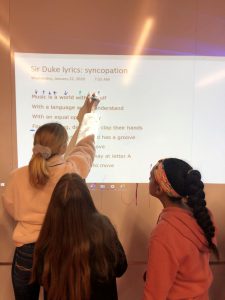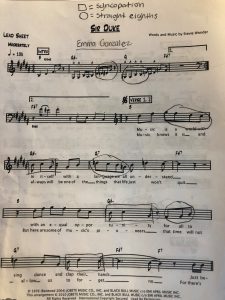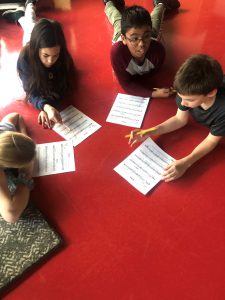(1) considers and addresses each student’s learning profile
(2) designs class activities and assignments that engage and accommodate for both individual students and a diverse group of learners
(3) builds in opportunities for each student to contribute during each class period
(4) provides alternative explanations of course concepts
(5) adapts instruction based on formative assessment
The very nature of a music rehearsal is an example of formative assessment in action and invites individuals to access content through a variety of ways. Differentiated experiences can be designed by leveraging the many ways music content can be accessed and manipulated through movement, sound, and in writing. We can move, listen, analyze and create. Instruction that leverages these varied approaches invites a diverse group of learners to be successful, and provides alternative explanations to course content. It is such a fun thing to design around in a music rehearsal. I love taking one musical concept, a musical motive, for example, and crafting multiple ways around it in which to learn.
In our recent middle school winter concert, that concept was syncopation. Stevie Wonder’s song Sir Duke inspired and provided excellent material for this. A tenet of music education that speaks to me is “sound before sight,” or, experiencing the music first and only afterward analyzing notation. First, we explored the opposite of syncopation. We listened and moved to music that was ON the beat, we marched around the room, threw our hair around and headbanged, and punched the air in time. Contrasting that with syncopation, or music that is in between beats, we found we could no longer march but had a bounce in our step, our shoulders and head moved opposite each other instead of together, and our punches had more pull than punch. Our final exploration of syncopation through movement was in tapping our toes up and down as we sang through the melody.
After the students got the feel of syncopation through movement (which sadly for you I did not think to capture on video) we analyzed the notation to understand how the sound is represented with symbols.  The first set of symbols we used to do this was arrows (Ped-10). Up and down arrows are symbols already known to students, and they reflect the direction of the feet as they tap toes along to the music – toes go down on the down beat and up on the up beat. It is a very seamless way of introducing symbols for sound. After the students explored this by completing an assignment of drawing correct arrows on Sir Duke lyrics, I introduced the classical music notation on the sheet music. The assignment was to draw a box around music that was on the beat, and circle music that was syncopated (Ped-11).
The first set of symbols we used to do this was arrows (Ped-10). Up and down arrows are symbols already known to students, and they reflect the direction of the feet as they tap toes along to the music – toes go down on the down beat and up on the up beat. It is a very seamless way of introducing symbols for sound. After the students explored this by completing an assignment of drawing correct arrows on Sir Duke lyrics, I introduced the classical music notation on the sheet music. The assignment was to draw a box around music that was on the beat, and circle music that was syncopated (Ped-11). At this point in the unit, students had been exposed to the concept of syncopation in many different ways (2, 4) and had learned much more than just “how Sir Duke goes” as if they were singing along with the radio (which is always a concern of mine when we do known music).
At this point in the unit, students had been exposed to the concept of syncopation in many different ways (2, 4) and had learned much more than just “how Sir Duke goes” as if they were singing along with the radio (which is always a concern of mine when we do known music).
In considering each students learning profile (1) I read learning plans as well as ask for verbal and written introductions at the beginning of the trimester (Ped-9). This allows me to get a sense of the students’ previous music education so I can know who will need extension activities. In our Sir Duke example above, students with demonstrated proficiency in music notation had to complete the written analysis as a dictation exercise. Instead of analyzing notation they wrote the rhythm from listening to it, a much more sophisticated skill.  Music offers so many different access points that all learners can find something that works for them and learn to persist through struggling through a methods that were more challenging.
Music offers so many different access points that all learners can find something that works for them and learn to persist through struggling through a methods that were more challenging.
A traditional rehearsal is the continuous practice of formative assessment (5), with the teacher constantly responding to and modifying sound. The conductor must know her musical goal and have a set of strategies to get their ensemble to the goal. The practice of formative assessment in a music classroom is to respond very specifically to the sound that the students are making in such a way that they change their sound to the one that reflects the artistic goal of the conductor (Ped-12). An example of formative assessment. At 1’40” in the video below of a rehearsal from the 2017-18 school year, I stop the choir after hearing an error. I give them direct feedback showing them what I want, and we immediately resume. If I remember correctly, at this time we were close to the performance date. Earlier in the trimester, my feedback to them may have been more exploratory or seeking student input.
The conductor must understand where the students are coming from. For example, teaching the 7am class is very different than 12:30. What the students need from me in order to have a productive class is very different. Similarly there might be a class where everyone is singing flat, or mumbling, or lacking breath support, I need to quickly pivot to address what they are doing, and not just pursue what I had wanted to do that day. Equally important is the ability to sense diminishing returns of a particular exercise or point. Musicianship is developed over the long term and sometimes pursuing improvement in the moment is not as productive as letting it go and returning to the same thing on a different day. Throughout this giant exercise of formative assessment, students are involved in artistic decision making, and giving feedback to the group through the reflection process (3) (Ped-7).
In my future practice, I would like to continue working on involving the students in the artistic decision making process. One sticking point in my profession that I spin on at times is how to create opportunities to involve students in what is traditionally a very conductor, or adult, driven experience. Creating space for the students to be involved in the artistic decision making process, in leading rehearsal (Ped-5) and designing concerts, has been important to me in the pursuit of developing musicians who are artists. To this end, I have developed class projects around mash-ups, designed to put artistic decision making in the hands of the students, as well as created opportunities for students to excel individually. One time a middle school student played piano accompaniment in a concert. Upper schoolers have conducted (Himi Mughal) or stage directed movement (Sebastian Pedersen). Countless students have made repertoire suggestions and voiced opinions and lead warm ups and games. I will continue to better hone this experience in the classroom. In the gradual release model of learning, the teacher begins with all of the responsibility for performing, and over time transitions that responsibility to the students. I would love to build a thriving student lead-program that practices inclusivity by utilizing the multifaceted nature of music in designing varied rehearsals.